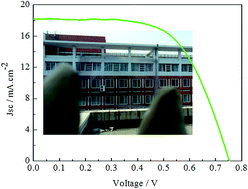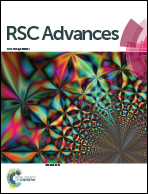A strategy to enhance overall efficiency for dye-sensitized solar cells with a transparent electrode of nickel sulfide decorated with poly(3,4-ethylenedioxythiophene)
Abstract
To improve the power conversion efficiency of dye-sensitized solar cells (DSSCs), a DSSC based on a transparent counter electrode (CE) and a piece of new aluminium foil as a reflector was devised. Owing to the simultaneous sunlight irradiation from the rear side, more dye molecules are excited and more carriers are generated, which greatly enhances the short-circuit current density and power conversion efficiency. In this work, a transparent electrode of nickel sulfide decorated with poly(3,4-ethylenedioxythiophene) (NiS/PEDOT) was prepared by a two-step electrochemical/chemical process. The NiS/PEDOT hybrid electrode utilizes the advances made in the use of NiS and PEDOT as the counter electrode for DSSCs. The incorporation of PEDOT conductive networks provides additional pathways for electron transport in the NiS/PEDOT hybrid electrode and thus facilitates increasing charge-transfer rate at the interface of the CE/electrolyte. The DSSC based on the NiS/PEDOT CE and a piece of new aluminium foil as a reflector achieved a higher power conversion efficiency of 8.47% compared to that of a DSSC irradiated from the front only (7.77%) under the irradiation of 100 mW cm−2 (AM 1.5G). The strategy of adding new aluminium foil as a reflector is of practical maneuverability and reference use than that of used two lights or mirrors, which provides a new and promising approach for enhancing the photovoltaic performances of solar cells in practice.


 Please wait while we load your content...
Please wait while we load your content...